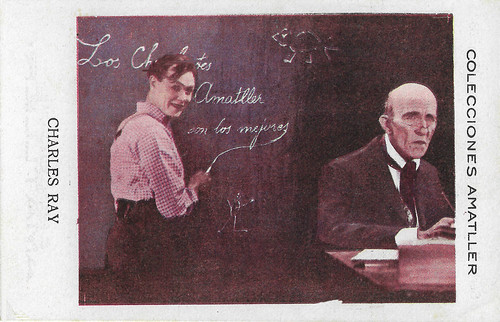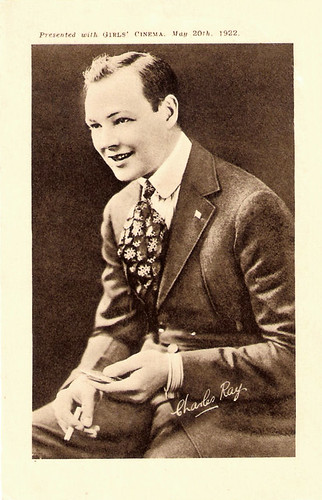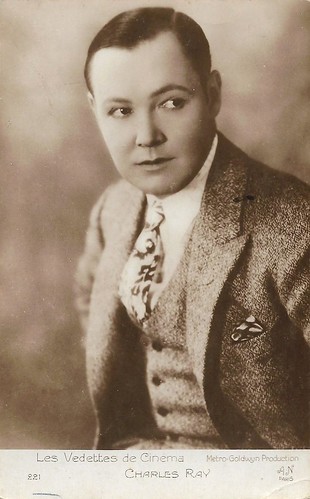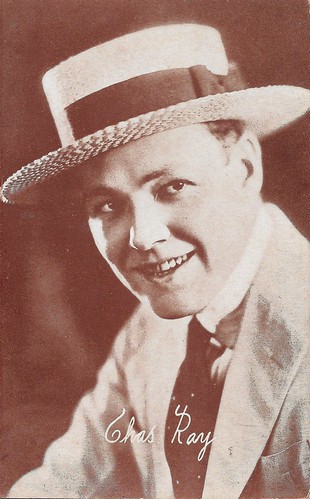Charles Ray (1891-1943) was an American actor, scriptwriter, and director of the silent screen, who knew a parabola from rags to riches and back again. He worked for e.g. Paramount, his own company, United Artists and MGM. In the late 1910s and early 1920s, he was a very popular actor and one of Hollywood's best-paid stars.

Spanish collectors card in the Collecciones Amatller Series, Serie X, artist no. 28, no. 63, by Chocolate Amatller. Photo: United Artists. Charles Ray and Lon Poff in The Old Swimmin' Hole (Joe de Grasse, 1921).

Spanish postcard.

Spanish postcard. Photo: Evans, Los Angeles.
Charles Edgar Ray was born in Jacksonville, Illinois, in 1891. He moved several times in his youth before settling Los Angeles, where he finished his education.
Ray started his career as an actor on stage. Later he also began to act in short silent films, making his debut as an extra in The Fortunes of War (Thomas Ince, 1911). He appeared in several bit parts before moving on to supporting roles.
From 1913 he had a steady career as the male lead in one- and two-reel short Western, Quaker, and Civil War dramas at Kaybee Pictures, Broncho Pictures, and Domino Pictures. In these films, he would be paired with actresses such as Enid Markey, Bessie Barriscale, Louise Glaum, and Dorothy Davenport.
Ray must have worked fast then, as in 1913 and in 1914 he had a ratio of a film every two weeks. At Kaybee, Ince would direct him at times, at times also Raymond West, while at Bronco he was often directed by Charles Giblyn, and in 1915 a few times by William S. Hart.
In 1915, Ray had his breakthrough in his first feature The Coward, produced by Thomas Ince for Kay-Bee and directed by Reginald Barker. In this Civil War drama, Ray played the son of a Virginia colonel (Frank Keenan), who needs to overcome his cowardice.

British postcard by Cinema Chat. Photo: Paramount.

British postcard, presented with Girl's CINEMA, May 20th, 1922.
Charles Ray's popularity rose after appearing in a series of films, as Wikipedia writes "which cast him in juvenile roles, primarily young, wholesome hicks or naive 'country bumpkins' that foiled the plans of thieves or con men and won the heart of his dream girl."
Ray's Kay-Bee films were now distributed by Triangle Distributing. Victor Schertzinger, the musician who had provided the music for The Coward, turned director at Kay-Bee and directed Ray in several films in 1917.
Ray, Ince, and Schertzinger moved over to Paramount in 1917, where Ince got his own production company and where Schertzinger directed Ray in more films, such as The Claws of the Hun (Victor Schertzinger, 1918), a propaganda film signalling the US's participation in the First World War.
Ray's star rose and rose. By 1920, he was earning a reported $11,000 a week (approximately $138,000 today). Ray had also earned a reputation for being egomaniacal and difficult to work with.
In 1920, he left Paramount after studio head Adolph Zukor refused to give him a substantial pay raise. Ray started his own production company. Charles Ray Productions, and bought a studio on Sunset Boulevard where he began producing and shooting his own films.
While he initially was fairly successful, an experiment for First National with a film without intertitles, The Old Swimmin' Hole (1921), co-starring Laura La Plante, had critical but not a huge popular success. Mind you, this was years before Friedrich Wilhelm Murnau's famous Der Letzte Mann/The Last Laugh (F.W. Murnau, 1924), which was made with only one intertitle.

French postcard in the Les Vedettes de Cinéma series by A.N., Paris, no. 221. Photo: Metro-Goldwyn-Mayer.

French postcard by Editions Cinémagazine, no. 79. Photo: not indicated but possibly by Evans.
In 1922, Charles Ray signed a contract with United Artists and starred in e.g. The Girl I Loved (1923) with Patsy Ruth Miller. He was fed up with the hillbillies types and strove to profile himself as a romantic lead and man of the world.
Against everybody's advice to avoid lengthy historical drama, Ray insisted on the making of The Courtship of Miles Standish (1923), investing $500,000 (approximately $7,353,000 today) of his own money, including a $65,000 (approximately $956,000 today) 180-ton replica of the Mayflower. The film was a box office failure, Ray lost all his money and his reputation went down too.
It did not mean his career was all over (despite what Wikipedia writes), because he first continued as a leading actor at smaller companies, produced by Ince, and in 1925 he got a contract at MGM, where he played for two years and acted as the male lead opposite actress such as Pauline Starke, Joan Crawford, and May McAvoy.
In those years Ray and his wife Clara Grant were enormous spendthrifts, with an over-the-top villa in Beverly Hills, a huge staff, and expensive cars. Grant would never wear a dress two times. Yet, in December 1925 Ray had to file for bankruptcy and his production company went under as well.
Though he continued to act, after MGM the companies he worked for were less prestigious, such as Universal. In 1928 he made his last silent film, The Count of Ten (James Flood, 1928), after which he acted on stage for years, in off-Broadway productions, without much success.
In 1932 Ray returned to the sets, but without success and in 1934 he declared for bankruptcy again. In 1935 he got divorced from Clara Grant, from whom he was already separated as of 1930. Ray still acted in cinema but in the mid-1930s in minor parts and in the early 1940s on uncredited parts. He tried to earn money by writing short stories and a popular movie magazine but to no avail.
Charles Ray died of a systemic infection caused by an impacted wisdom tooth in 1943. He was only 52. In 1960 he received a star on the Hollywood Walk of Fame for his contribution to the motion picture industry.

British postcard.

American postcard.

American postcard. Home of Charles Ray, Beverly Hills, Los Angeles, Cal.
Sources: Wikipedia (English, French and Italian), and IMDb.

Spanish collectors card in the Collecciones Amatller Series, Serie X, artist no. 28, no. 63, by Chocolate Amatller. Photo: United Artists. Charles Ray and Lon Poff in The Old Swimmin' Hole (Joe de Grasse, 1921).

Spanish postcard.

Spanish postcard. Photo: Evans, Los Angeles.
A film every two weeks
Charles Edgar Ray was born in Jacksonville, Illinois, in 1891. He moved several times in his youth before settling Los Angeles, where he finished his education.
Ray started his career as an actor on stage. Later he also began to act in short silent films, making his debut as an extra in The Fortunes of War (Thomas Ince, 1911). He appeared in several bit parts before moving on to supporting roles.
From 1913 he had a steady career as the male lead in one- and two-reel short Western, Quaker, and Civil War dramas at Kaybee Pictures, Broncho Pictures, and Domino Pictures. In these films, he would be paired with actresses such as Enid Markey, Bessie Barriscale, Louise Glaum, and Dorothy Davenport.
Ray must have worked fast then, as in 1913 and in 1914 he had a ratio of a film every two weeks. At Kaybee, Ince would direct him at times, at times also Raymond West, while at Bronco he was often directed by Charles Giblyn, and in 1915 a few times by William S. Hart.
In 1915, Ray had his breakthrough in his first feature The Coward, produced by Thomas Ince for Kay-Bee and directed by Reginald Barker. In this Civil War drama, Ray played the son of a Virginia colonel (Frank Keenan), who needs to overcome his cowardice.

British postcard by Cinema Chat. Photo: Paramount.

British postcard, presented with Girl's CINEMA, May 20th, 1922.
Country Bumpkins
Charles Ray's popularity rose after appearing in a series of films, as Wikipedia writes "which cast him in juvenile roles, primarily young, wholesome hicks or naive 'country bumpkins' that foiled the plans of thieves or con men and won the heart of his dream girl."
Ray's Kay-Bee films were now distributed by Triangle Distributing. Victor Schertzinger, the musician who had provided the music for The Coward, turned director at Kay-Bee and directed Ray in several films in 1917.
Ray, Ince, and Schertzinger moved over to Paramount in 1917, where Ince got his own production company and where Schertzinger directed Ray in more films, such as The Claws of the Hun (Victor Schertzinger, 1918), a propaganda film signalling the US's participation in the First World War.
Ray's star rose and rose. By 1920, he was earning a reported $11,000 a week (approximately $138,000 today). Ray had also earned a reputation for being egomaniacal and difficult to work with.
In 1920, he left Paramount after studio head Adolph Zukor refused to give him a substantial pay raise. Ray started his own production company. Charles Ray Productions, and bought a studio on Sunset Boulevard where he began producing and shooting his own films.
While he initially was fairly successful, an experiment for First National with a film without intertitles, The Old Swimmin' Hole (1921), co-starring Laura La Plante, had critical but not a huge popular success. Mind you, this was years before Friedrich Wilhelm Murnau's famous Der Letzte Mann/The Last Laugh (F.W. Murnau, 1924), which was made with only one intertitle.

French postcard in the Les Vedettes de Cinéma series by A.N., Paris, no. 221. Photo: Metro-Goldwyn-Mayer.

French postcard by Editions Cinémagazine, no. 79. Photo: not indicated but possibly by Evans.
The Sinking of the Mayflower
In 1922, Charles Ray signed a contract with United Artists and starred in e.g. The Girl I Loved (1923) with Patsy Ruth Miller. He was fed up with the hillbillies types and strove to profile himself as a romantic lead and man of the world.
Against everybody's advice to avoid lengthy historical drama, Ray insisted on the making of The Courtship of Miles Standish (1923), investing $500,000 (approximately $7,353,000 today) of his own money, including a $65,000 (approximately $956,000 today) 180-ton replica of the Mayflower. The film was a box office failure, Ray lost all his money and his reputation went down too.
It did not mean his career was all over (despite what Wikipedia writes), because he first continued as a leading actor at smaller companies, produced by Ince, and in 1925 he got a contract at MGM, where he played for two years and acted as the male lead opposite actress such as Pauline Starke, Joan Crawford, and May McAvoy.
In those years Ray and his wife Clara Grant were enormous spendthrifts, with an over-the-top villa in Beverly Hills, a huge staff, and expensive cars. Grant would never wear a dress two times. Yet, in December 1925 Ray had to file for bankruptcy and his production company went under as well.
Though he continued to act, after MGM the companies he worked for were less prestigious, such as Universal. In 1928 he made his last silent film, The Count of Ten (James Flood, 1928), after which he acted on stage for years, in off-Broadway productions, without much success.
In 1932 Ray returned to the sets, but without success and in 1934 he declared for bankruptcy again. In 1935 he got divorced from Clara Grant, from whom he was already separated as of 1930. Ray still acted in cinema but in the mid-1930s in minor parts and in the early 1940s on uncredited parts. He tried to earn money by writing short stories and a popular movie magazine but to no avail.
Charles Ray died of a systemic infection caused by an impacted wisdom tooth in 1943. He was only 52. In 1960 he received a star on the Hollywood Walk of Fame for his contribution to the motion picture industry.

British postcard.

American postcard.

American postcard. Home of Charles Ray, Beverly Hills, Los Angeles, Cal.
Sources: Wikipedia (English, French and Italian), and IMDb.
No comments:
Post a Comment